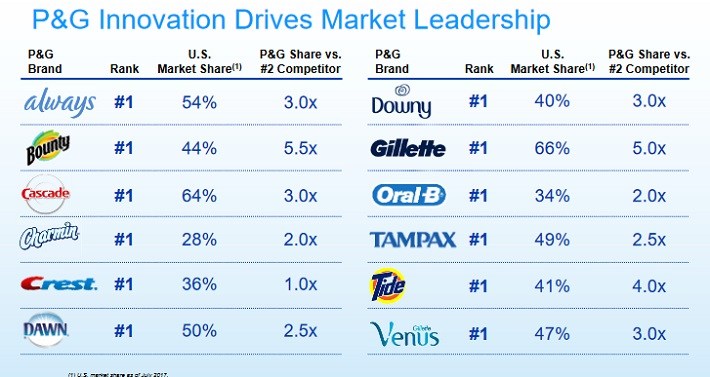Procter & Gamble (PG) stock has lost 16% since it peaked, six months ago. The stock has dramatically under-performed the S&P in almost any time frame one can check out. To be sure, it has under-performed the market index during the last 5 years (2% vs. 79%!), 2 years (-5% vs. 36%) and the last 12 months (-14% vs. 15%).
And yet, P&G has one of the longest streaks of dividend growth in the entire stock market. It is a Dividend King, a group of just 25 stocks that have increased their payouts for at least 50 consecutive years. You can see the full list of all 25 Dividend Kings here.
Click here to download my Dividend Kings Excel Spreadsheet now. Keep reading this article to learn more.
This article will discuss the company’s fundamentals, and why the stock may be interesting for dividend growth investors.
Business Overview
Procter & Gamble is a consumer stalwart that is 180 years old and sells its products in more than 180 countries. It generates 55% of its sales outside North America, with 35% of its sales in emerging regions.

Source: Barclays Global Consumer Conference, page 8
The performance record of the company for almost two centuries is certainly admirable. Nevertheless, during the last decade, the consumer stalwart has faced some strong headwinds, which have challenged its growth trajectory.
The greatest headwind is the continuously heating up of competition in the retail sector. As consumers are becoming increasingly price-conscious, private-label products are gaining popularity and are thus gaining market share while also exerting downward pressure on the prices of their competitors.
In addition, large retailers, such as Walmart (WMT) and Target (TGT), are in a price war and hence they exert great pressure on their suppliers for lower prices. Consequently, Procter & Gamble has seen its gross and operating margins remain essentially flat during the last decade, around 50% and 20%, respectively. Moreover, the company has failed to grow its revenues for six consecutive years.
Part of the decrease in the revenues can be attributed to the unprecedented sale of brands in the last few years but even the core revenues have not grown for six years. Furthermore, the company has essentially failed to grow its earnings-per-share for a whole decade.
Growth Prospects
While the above headwinds help explain the stagnation of Procter & Gamble, the company also has another problem, namely its own size. As it has a market cap of approximately $200 billion, and has already expanded in almost every country on the planet, it is only natural that it finds it increasingly hard to grow.














Leave A Comment